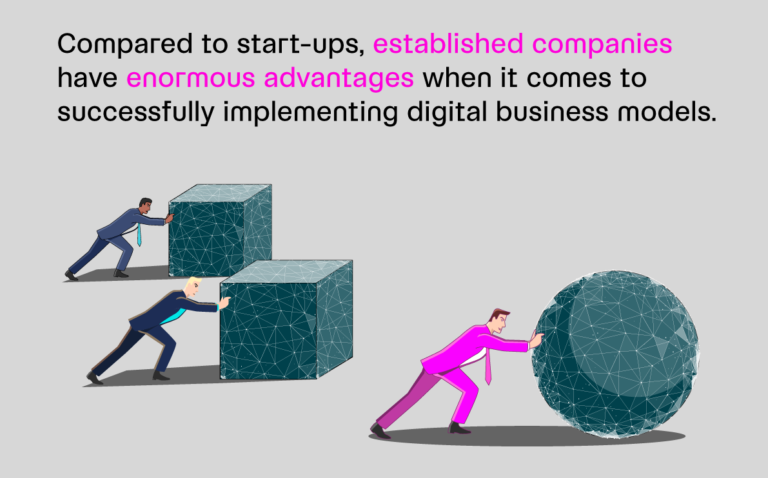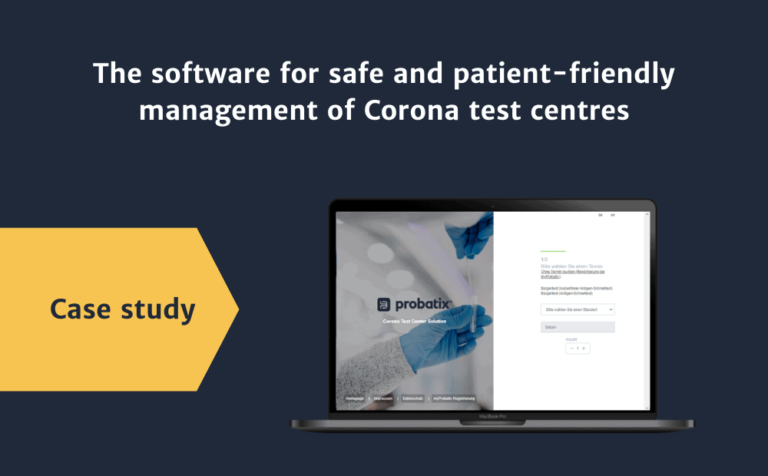The e-health law and the transition to the telematics infrastructure (TI) are promoting a disruption in the health sector on the German market. This is an opportunity for both established companies and start-ups to develop new digital business models for the health sector. Building a platform offers the opportunity for an impactful, scalable and successful business model because it combines many customer-focused features:
- Reduction of complexity
- Simplification through standardisation
- Reduction of information asymmetries
- Platforms operate within existing ecosystems
- Platforms are scalable and increase value for both users and their providers
Especially for established companies that are already active in the health sector, building a platform is an attractive business model. Compared to start-ups, these companies have several advantages. Established companies
- have an existing network of customers, suppliers and partners
- know what their customers’ and partners’ needs are
- are already constantly developing new products and services: Keyword incremental innovation
- are usually more familiar with medical law in order to develop medical products and services that meet legal requirements
- can use their existing products and services to build a platform based on them
With platforms, established companies in the health sector can harness digital transformation for themselves, their customers and patients, and suppliers. The health sector offers numerous sectors for platforms.
- Telematics infrastructure
- Services for patients (e.g. appointment scheduling, doctor ratings, patient portals)
- Video consultations/conferences
- Messenger services in hospitals
- Telemedicine systems, including teleconsultation/telemonitoring
- Health records of the health insurances
- Joint R&D platforms
- Purchasing platforms/online marketplaces
Examples of platforms offering their services in the healthcare or pharmaceutical industry are: teamplay digital health platform, central healthcare platform “ZHP.X3”, Hartmann easy, data4life, smart4health, Doctolib, Netdoktor, Qualimedic, Lifeline, zhkplus, Aponet, Arzt-Auskunft, Med-Kolleg, PraxisVITA, Vitanet, afgis, doccheck, Medizin.de, PharmaFlash, pharma4u, Pharmazie.com
A platform requires new thinking: in partnerships
After the Apple App Store was developed, even Steve Jobs had to start thinking in new terms of cooperation and partnerships. Steve Jobs originally wanted only Apple to develop for the App Store. Legend has it that it took a lot of convincing by his employees to open up the App Store to other developers as well. And as we know: it was only after apps from other developers were offered on the Apple Store that the App Store became the successful platform it is today.
Other examples of platforms that only work because they are open to partners are Amazon, Zalando, Blinkist, Inkitt, Artnight, Udemy, Quora, Hartmann Easy, XING, LinkedIn, Ebay, fiverr, upwork, Etsy, Mercateo, BCAP (Bilfinger Connected Asset Performance, CENTERSIGHT, KREATIZE.
The most common platform model is that of the marketplace. In the B2B sector in particular, there are other forms of platforms. These include
- Retail and manufacturing platforms
- Supply chain or logistics platforms
- Networking platforms
- Industrial Internet of Things (IIoT) platforms
- Data (transaction) platforms
Tools to develop the business model of a digital platform
Classic business models are developed with a business plan or evaluated with the Business Model Canvas. A platform is a business model with other customer-supplier relationships. Examples are the interaction between a network of suppliers and customers and the fact that suppliers can also be customers and customers can be suppliers. DeTherefore, special tools have been developed to build a platform business model, such as the Platform Canvas https://www.theplatformcanvas.com/ or the Platform Innovation Kit https://platforminnovationkit.com/.
The final step: implementation
Once the business model is developed, it must be implemented. Data protection and security should be at the forefront of this. We are at your disposal for each step: Evaluation of your business model – Design of a prototype – Development of an MVP – Go-live of your platform – Scaling.
Let’s talk about your digital business model
Regardless of whether you have an initial rough idea, a digital product or a concrete business model in mind, we are available to talk to you without obligation.





